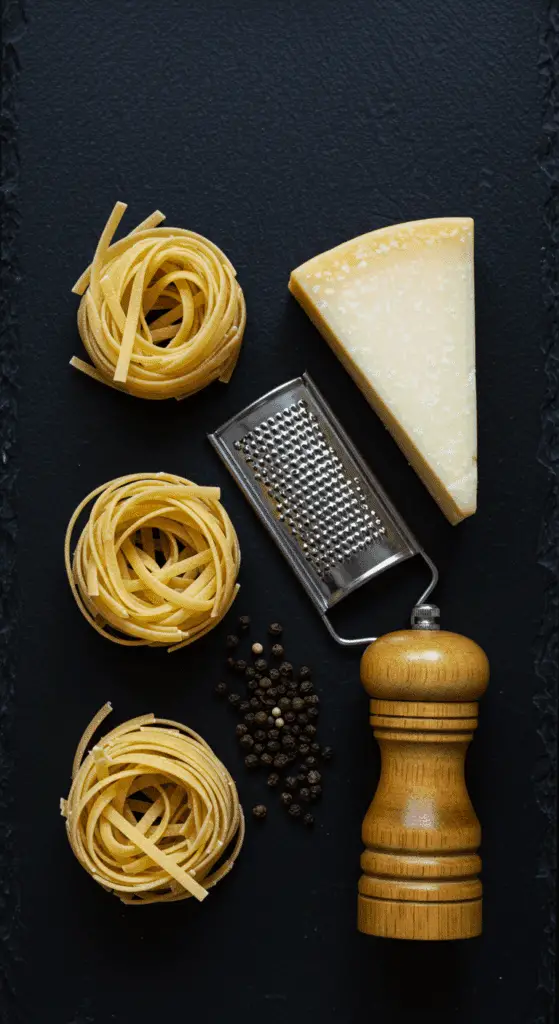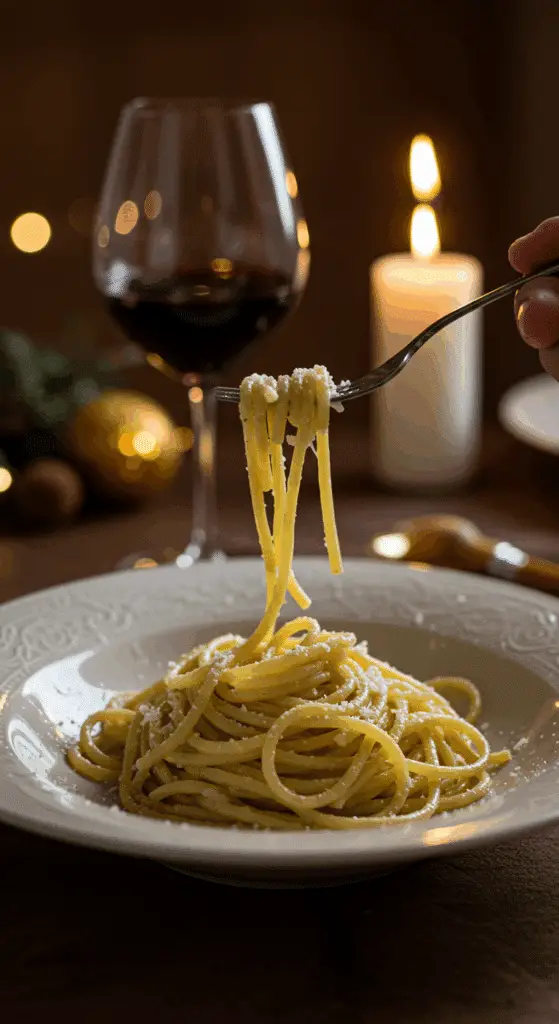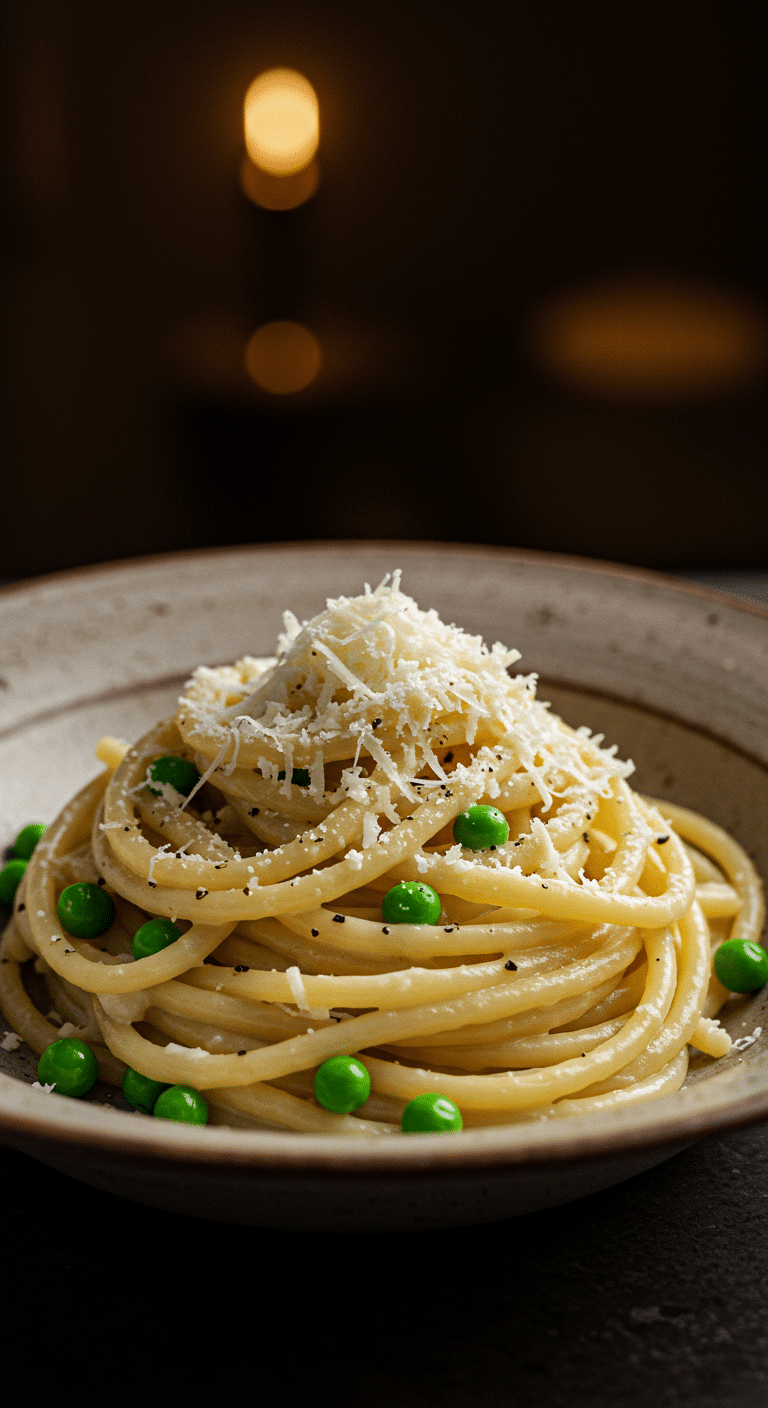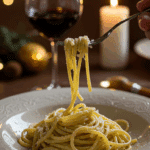Are you ready to master one of Rome’s most iconic, elegant, and delicious pasta dishes? A meal so simple, yet so profoundly flavorful and satisfying, it feels like a beautiful magic trick? This incredible, authentic-tasting Bucatini Cacio e Pepe is your ultimate guide to that very masterpiece. We’re talking tender, chewy pasta, enrobed in a luscious, peppery, and unbelievably creamy sauce made without a single drop of cream—just cheese, pepper, and the magic of starchy pasta water.
This isn’t just another pasta recipe; it’s a guide to a foundational pillar of Italian cooking. While it’s famous for its minimalist ingredient list, it’s also notorious for being tricky. But fear not! We’ll show you the simple but crucial, foolproof technique to a perfectly smooth, velvety, and non-clumpy sauce every single time. Get ready to create a truly unforgettable pasta night.
Table of Contents
Table of Contents
Recipe Overview: The Ultimate Minimalist Masterpiece
What makes Cacio e Pepe (cheese and pepper) so spectacularly delicious is its incredible, bold flavor, derived from just three core ingredients. This recipe is a masterpiece of Roman simplicity. The heart and soul of the dish is a perfect emulsion of three simple things: sharp, salty Pecorino Romano cheese, a fragrant and spicy bite from freshly cracked black pepper, and the starchy “liquid gold” from the pasta cooking water. When combined correctly, these simple ingredients transform into an impossibly creamy, luscious sauce that clings beautifully to every strand of the classic, thick and hollow bucatini pasta. This version adds a fun and sweet pop of freshness with some frozen peas, a common and delicious modern twist.
| Metric | Time / Level |
| Total Time | 20 minutes |
| Active Prep Time | 20 minutes |
| Difficulty Level | Easy (with the right technique!) |
| Servings | 4 |
The Roman Trinity: The Essential Ingredients
The beauty of this recipe is in its simplicity, which means the quality of your few ingredients is absolutely paramount.
- The Cacio (The Cheese):
- Pecorino Romano: For a truly authentic Cacio e Pepe, it is essential to use a high-quality, sharp, and salty Pecorino Romano cheese, which is a hard, sheep’s milk cheese.
- The #1 Most Important Secret: You must, must, must use a block of cheese that you grate yourself, very finely. Pre-shredded, bagged cheeses are coated in starches (like potato starch or cellulose) to prevent them from clumping. These anti-caking agents are the number one culprit behind a grainy, stringy, and disastrously clumpy sauce.
- The Pepe (The Pepper):
- For the best, most aromatic, and vibrant flavor, it is essential to use whole black peppercorns that you grind yourself, coarsely. The technique of gently toasting the pepper in the pan before adding any liquid is a brilliant trick that awakens its essential oils and makes it incredibly fragrant.
- The Pasta: A long, sturdy, and high-quality pasta is a must. A classic bucatini (a thick spaghetti with a hole through the center) is a fantastic and traditional choice.
- The “Liquid Gold” (Starchy Pasta Water!): This is the most important “secret” ingredient for a perfect sauce! The cloudy, starchy, salty water left over from cooking your pasta is the magic, natural emulsifier that transforms the simple cheese and pepper into a cohesive, silky, and surprisingly creamy sauce.
The Emulsification Masterclass: The Secret to a Perfect, Non-Clumpy Sauce
This is the most crucial part of the recipe and the step where most people go wrong. The key is to not add your cheese directly to a screaming hot pan.
- Create a Paste: The foolproof secret to a smooth sauce is to create a thick, creamy paste with your finely grated cheese and a little bit of the starchy pasta water in a separate, large mixing bowl.
- Add the Hot Pasta: You will then add your hot, cooked pasta directly from the pot into this bowl with the cheese paste.
- Toss Vigorously: The final step is to toss everything together vigorously. The residual heat from the pasta will gently melt the cheese, and the vigorous tossing, combined with a little extra hot pasta water, is the magic that emulsifies the fat from the cheese with the starch from the pasta, creating a perfect, luscious, and creamy sauce that will never clump.

Step-by-Step to the Best Cacio e Pepe
This elegant meal comes together in the time it takes to boil your pasta.
Step 1: Cook the Pasta (and Reserve That Liquid Gold!)
First, bring a large pot of heavily salted water to a boil. Add your 12 ounces of Bucatini pasta and cook according to the package directions until it is perfectly al dente.
Crucial Pro Tip: Just before you drain the pasta, be sure to reserve at least 1 full cup of the starchy, salty pasta water. This is the most important ingredient for your sauce!
Part 2: The Secret to a Perfect, Creamy Sauce
Step 1: While the pasta is cooking, in a large skillet, add your 1/3 cup of olive oil and toast the 2 teaspoons of coarsely ground black pepper over a low heat for just about 30 seconds, until it is very fragrant.
Step 2 (The Most Important Step!): In a separate, large mixing bowl, combine your 3/4 cup of grated Parmesan cheese, your 1/2 cup of grated Pecorino Romano cheese, and the 1/2 teaspoon of salt. Add just a few tablespoons of your reserved pasta water to the cheese and mix it into a thick, uniform paste.
Part 3: Combine, Emulsify, and Serve
Step 1: Add your hot, drained pasta directly to the large mixing bowl with your cheese paste. Step 2: Use a pair of tongs to toss the pasta vigorously and continuously, until the cheese paste has melted and has begun to form a creamy sauce that is coating the noodles. Step 3: Continue to toss, adding another splash of your hot, reserved pasta water as needed, until the sauce is perfectly smooth, luscious, and clinging beautifully to every single noodle. Step 4: Stir in your 1 cup of frozen peas and continue to toss until they are warmed through.
Serve the hot Cacio e Pepe immediately in warm, shallow bowls, with an extra sprinkle of grated Pecorino and some more freshly cracked black pepper.

Authentic Cacio e Pepe (An Easy, Creamy Recipe!)
A simple recipe for a classic Roman pasta dish, Bucatini Cacio e Pepe, which translates to ‘cheese and pepper.’ This version features thick, hollow bucatini pasta tossed in a simple yet flavorful sauce. The sauce is an emulsion created from a blend of Parmesan and Pecorino Romano cheeses, coarsely ground black pepper that has been toasted in olive oil, and the starchy water from cooking the pasta. This recipe also includes the non-traditional addition of sweet green peas.
Ingredients
- 12 ounces Bucatini pasta
- 1/3 cup olive oil
- 2 teaspoons coarsely ground black pepper
- 3/4 cup grated Parmesan cheese
- 1/2 cup grated Pecorino Romano cheese
- 1/2 teaspoon salt
- 1 cup frozen peas
Instructions
- Bring a large pot of salted water to a boil. Cook the bucatini pasta according to the package directions until al dente. Before draining, reserve at least 1/3 cup of the starchy pasta water.
- While the pasta is cooking, heat the olive oil in a large skillet over low heat. Add the coarsely ground black pepper and toast for about 30 seconds, until it becomes very fragrant.
- Add the Parmesan cheese, Pecorino Romano cheese, salt, and the reserved 1/3 cup of pasta water to the skillet.
- Add the cooked, drained pasta to the skillet and toss everything together over low heat for about a minute, until the cheese has melted and created a creamy sauce that coats the noodles.
- Stir in the frozen peas and continue to cook until they are heated through. Serve immediately.
Notes
- The name ‘Cacio e Pepe’ literally means ‘cheese and pepper,’ highlighting the simple, key ingredients of this classic Roman dish.
- Toasting the black pepper in the olive oil is a crucial step that ‘blooms’ the spice and brings out its pungent, aromatic flavor.
- Using the starchy, reserved pasta water is essential for creating the creamy, emulsified sauce without using any cream.
- It is very important to keep the heat low when adding the cheese to prevent it from clumping or seizing.
Storage and Make-Ahead Tips
A delicate, emulsified pasta dish like this one is at its absolute peak of perfection in the moments right after it is made and is not ideal for making ahead or for leftovers.
- Storage: If you do have leftovers, you can store them in an airtight container in the refrigerator for up to 2 days.
- Reheating: The best way to reheat this dish is to do so gently in a skillet on the stovetop over a low heat. You will need to add a generous splash of water and a little extra butter or olive oil to help loosen the sauce and bring back some of its original, creamy consistency.
For more recipe follow my pinterest account
Frequently Asked Questions (FAQs)
Q1: What is the absolute, number one secret to a creamy, not clumpy, Cacio e Pepe?
The secret is to not add your cheese to a hot pan. By creating a cheese paste in a separate, room-temperature bowl and then using the residual heat of the hot pasta to gently melt the cheese while you toss it vigorously, you are creating a perfect, gentle emulsion. Adding cheese directly to a hot pan will cause the proteins in the cheese to seize up and clump together instantly.
Q2: What is the best kind of cheese to use for an authentic Cacio e Pepe?
A true, classic, and authentic Cacio e Pepe is made with 100% Pecorino Romano cheese. It has a wonderfully sharp, salty, and pungent flavor that is the signature of the dish. However, as this recipe suggests, using a blend of Pecorino and a milder, nuttier Parmesan is a fantastic and very popular variation that tones down the sharpness for a more approachable flavor.
Q3: Can I make this dish ahead of time?
This is one of the few pasta dishes that is at its absolute best when it is made and served immediately. Because the sauce is a delicate emulsion of cheese, starch, and water, it does not hold or reheat particularly well.
Q4: What is the best kind of pasta to use for Cacio e Pepe?
A long, sturdy pasta shape with a slightly rough, porous texture is the best choice for catching and holding onto the beautiful sauce. A classic bucatini is a fantastic choice, as is a traditional, bronze-die spaghetti or a tonnarelli.
Q5: Can I make this recipe without the peas?
Of course! The peas are a delicious and fun, modern addition that adds a wonderful pop of color and sweetness, but a classic, traditional Cacio e Pepe does not contain any peas.


